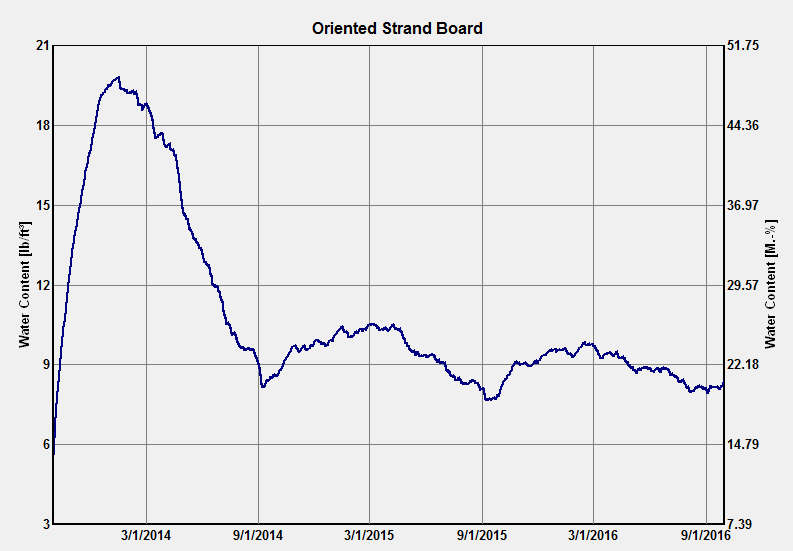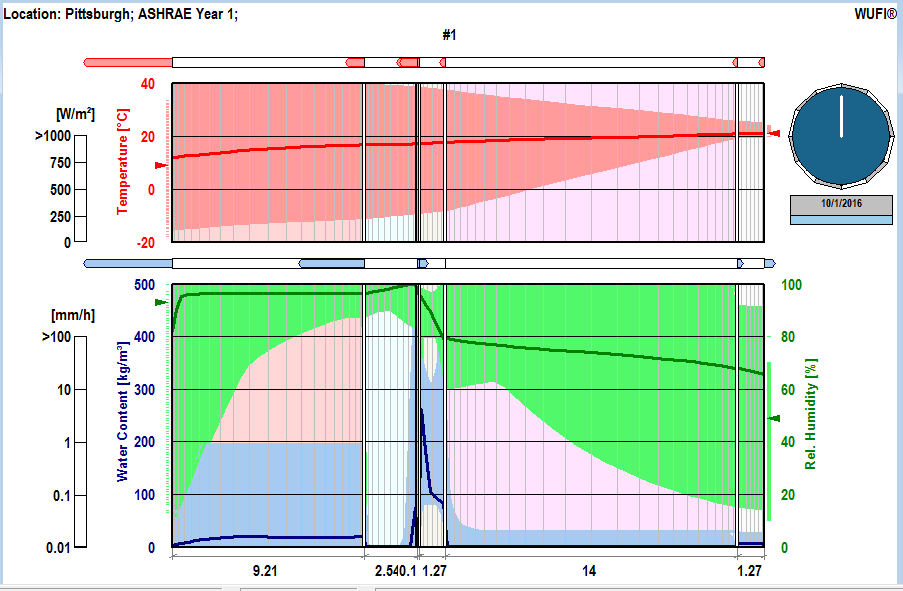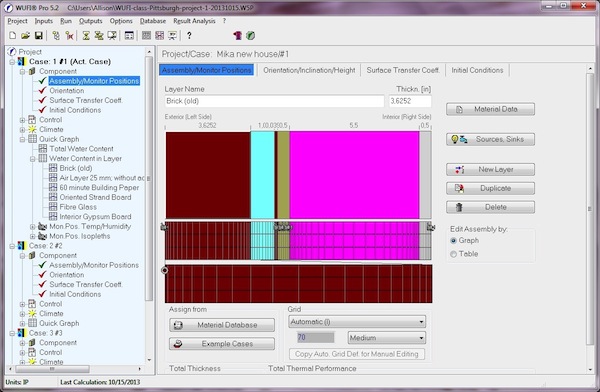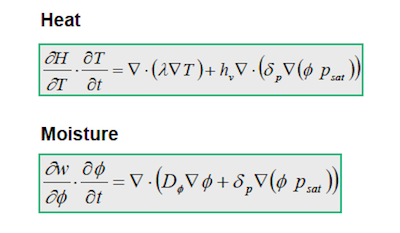5 Easy Steps to Understanding WUFI – Memento Style

 If you have any involvement with the world of building science, you may have heard about something called WUFI and wondered what the heck it is. Maybe you’ve heard that it’s a piece of software (several pieces, actually) that does hygrothermal modeling. Well, today’s your lucky day because I just went through a two-day class on WUFI 1-D with Dr. Achilles Karagiozis† and Mr. Mikael Salonvaara of Owens Corning, and I’ll give you the shortest explanation possible of what it’s all about. And I’ll give it to you the way we learned about Guy Pearce’s character in the movie Memento.
If you have any involvement with the world of building science, you may have heard about something called WUFI and wondered what the heck it is. Maybe you’ve heard that it’s a piece of software (several pieces, actually) that does hygrothermal modeling. Well, today’s your lucky day because I just went through a two-day class on WUFI 1-D with Dr. Achilles Karagiozis† and Mr. Mikael Salonvaara of Owens Corning, and I’ll give you the shortest explanation possible of what it’s all about. And I’ll give it to you the way we learned about Guy Pearce’s character in the movie Memento.
If you have any involvement with the world of building science, you may have heard about something called WUFI and wondered what the heck it is. Maybe you’ve heard that it’s a piece of software (several pieces, actually) that does hygrothermal modeling. Well, today’s your lucky day because I just went through a two-day class on WUFI 1-D with Dr. Achilles Karagiozis† and Mr. Mikael Salonvaara of Owens Corning, and I’ll give you the shortest explanation possible of what it’s all about. And I’ll give it to you the way we learned about Guy Pearce’s character in the movie Memento.
Other versions of WUFI do different things, so keep in mind that what you read below applies to the one-dimensional version of this hygrothermal modeling tool.
Step 5: WUFI Bio tells you if your assembly will grow mold.
Once you’ve done all the modeling, you can take your results to the add-on program, WUFI Bio, to see if your assembly will be wet enough to grow mold. The graph below shows a material that doesn’t dry out and ends up being a good mold factory. Note the red light at top left.

Step 4: WUFI shows how your the water content of the materials over time.
The graph below shows that the OSB sheathing in this wall assembly doesn’t dry sufficiently over the three year period of the simulation. Ideally, you’d like to see it stay below 15-16% (right axis).

Step 3: Run the simulation and watch what happens in the different layers.
The graph below is one screen shot of the animation you can watch as WUFI goes through all the calculations for moisture and heat flow, hour by hour. The top graph shows the temperature profile, from outdoors on the left to indoors on the right. The red line shows the temperature at that particular hour of the simulation. The pink area shows all the temperatures reached in the various layers, including the minimum and maximum.
The graph below with the green and blue lines and areas shows the moisture analysis. Relative humidity is in green and water content is in blue.

Step 2: Set up your assembly and enter all the inputs.
The screen shot below shows the main screen of WUFI 1-D. The first thing you do is set up the layers of your assembly. The one you see below has brick on the outside, a 1″ air space, building paper, oriented strand board, fiberglass insulation, and drywall. You choose and adjust the paramaters to match the actual materials being used.
You also set a lot of other parameters that control how the simulation will run: orientation, coatings, permeance of paint, climate, wind-driven rain, and initial conditions. The program gives you a lot of power to set everything up with hundreds of inputs. You really have to know what you’re doing to get this right or you could end up modeling a wall that WUFI says will be a disaster even though it’s been working well in the real world for decades. Or you could model a wall, as one architect did, that WUFI says will work fine and then your builder says they won’t build it because it won’t work.
Remember the GIGO principle: Gargage in, garbage out.

Step 1: Solve the partial differential equations for the flow of heat and moisture.
The equations are shown below. WUFI solves them numerically so you don’t have to.

That’s it. That’s what WUFI’s all about. I’ll have to come back to this topic because Joe Lstiburek, who likes to argue with everybody, and Achilles Karagiozis have had an ongoing clash over WUFI. Last year at the Passive House conference in Denver, Joe said that if you need to use WUFI, you’ve done something wrong. Achilles opened the two-day class I just took by saying, “No one can do hygrothermal analysis in their heads.” More on that later.
Now, if you want to go further back, go watch Guy Pearce play Felicia Jollygoodfellow in the movie, The Adventures of Priscilla Queen of the Desert.
Related Articles
Dr. Joe Lstiburek Surprises Passive House Conference Attendees
How Accurate Is REM/Rate as an Energy Modeling Tool?
Passive House — The Only Place Where Real Innovation Is Happening?
Footnote
†Achilles, by the way, is one of the most interesting and entertaining teachers I’ve had. He’s a dynamo who’s full of information and stories. Although he dashed my hopes with what he said to start the class (see my quote at the end of this article), I loved the class and his teaching style.
This Post Has 6 Comments
Comments are closed.

Allison..
Allison..
Please excuse my ignorance, but what does the acronym WUFI stand for..?
Reed D.:
Reed D.: WUFI stands for “Wärme- Und Feuchtetransport Instationär,” which translates as “German scientists create complex modeling tool for heat and moisture transport.” Or something like that.
Is that phi or psi? I can’t
Is that phi or psi? I can’t remember.
And, what is a one dimensional concentration?
Foster L.:
Foster L.: In the moisture equation, the main variable is the Greek letter phi. Concentration in one dimension is m^-1 or ft^-1.
Long time a go, I asked John
Long time a go, I asked John Straube if I needed to do WUFI analysis on my designs, and his answer was “if you need to impress an engineer, do a WUFI analysis, but for residential designs, performing ASHRAE Fundamentals analysis is more than acceptable”. Enough said for me.
Armando:
Armando: You may be putting more faith than is warranted in Professor Straube. The more airtight and insulated the house, the more you need to do a WUFI analysis.
Cameron T.: Yes, WUFI is absolutely suited for boots-on-the-ground building science forensics. Those who work as experts in lawsuits use it regularly. The answer to your last question is WUFI’s results will be more accurate and reliable if you plug in good field data rather than relying on databases.